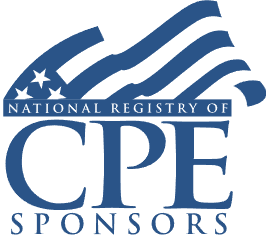AMT Reduction Strategies After Tax Reform: Identifying AMT Risks and Planning to Avoid AMT
TCJA Changes to the AMT Regime, Credits and Carryforward Calculations, and Reporting on Form 6251 and 8801

Course Details
- smart_display Format
On-Demand
- signal_cellular_alt Difficulty Level
Intermediate
- work Practice Area
Tax Preparer
- event Date
Thursday, January 10, 2019
- schedule Time
1:00 PM E.T.
- timer Program Length
110 minutes
-
BARBRI is a NASBA CPE sponsor and this 110-minute webinar is accredited for 2.0 CPE credits.
-
BARBRI is an IRS-approved continuing education provider offering certified courses for Enrolled Agents (EA) and Tax Return Preparers (RTRP).
-
Live Online
On Demand
This course will provide tax advisers with a practical guide to calculating and reporting alternative minimum tax (AMT) for individuals, and planning strategies to minimize the impact of the AMT. The panel will discuss the changes to the AMT regime included in tax reform and detail specific steps to lower the overall multi-year tax cost of AMT liability. The webinar will also offer line-by-line guidance in completing Form 6251.
Description
Somewhat surprisingly, the new tax reform law did not repeal the AMT, but it does offer some provisions to narrow the reach and impact of the AMT on individual taxpayers. The elimination of many itemized deductions, as well as the individual exemption amount, will have the effect of significantly reducing the number of taxpayers subject to AMT. However, for some high income taxpayers, AMT will remain in effect and may present calculation challenges as well as planning opportunities.
The AMT regime creates a separate, parallel calculation of income and deductions; however, under the AMT, certain deductions from ordinary taxable income are deemed as “tax preferences” and must be added back in calculating alternative minimum taxable income (AMTI). Additionally, taxpayers must maintain a schedule of AMT tax credits to apply to future AMT liabilities.
Tax advisers serving high net worth individuals must have a thorough grasp of AMT “risk factors” as well as the calculation regime of add-backs, adjustments and credits. By identifying a taxpayer’s AMT situation, alert advisers can implement end of year planning steps to minimize or avoid any AMT liability.
Listen as our experienced panel provides a thorough and practical guide to calculating AMTI and resulting tax, including Form 6251 reporting and planning opportunities to minimize the impact of the AMT.
Outline
- Structure of AMT and identifying AMT triggers
- Impact of tax reform on AMT
- Tax preferences, adjustments and exemptions to calculate AMTI
- Completing Form 6251
- Calculating AMT credit carryforwards
- Reporting credit carryforward on Form 8801
- Tax planning strategies to reduce overall tax cost impact of AMT
- Income timing plans such as multi-year cashouts of ISOs
- Whether to prepay certain tax bills not deductible for AMT purposes
- Possible acceleration of income into AMT year
Benefits
The panel will delve into these and other AMT-related topics:
- How tax reform’s elimination of certain deductions and personal exemption amounts narrowed the reach of taxpayers subject to AMT
- AMT triggers and planning steps (including timing decisions)
- Current AMT rates, exemptions, adjustments and preferences for individual taxpayers
- Determining the proper treatment of capital gains, NOLs, AMT carryover and other aspects
NASBA Details
Learning Objectives
After completing this course, you will be able to:
- Recognize the impact of tax reform on AMT preference items
- Identify specific tax preference items that must be added to taxable income to calculate AMTI
- Recognize the proper treatment of minimum tax and other tax credits
- Decide when income acceleration into an AMT year can benefit an individual taxpayer
- Field of Study: Taxes
- Level of Knowledge: Intermediate
- Advance Preparation: None
- Teaching Method: Seminar/Lecture
- Delivery Method: Group-Internet (via computer)
- Attendance Monitoring Method: Attendance is monitored electronically via a participant's PIN and through a series of attendance verification prompts displayed throughout the program
- Prerequisite:
Three years+ business or public firm experience at mid-level within the organization, preparing complex tax forms and schedules, supervising other preparers/accountants. Specific knowledge and understanding of Form 1040 preparation for high-income taxpayers; familiarity with Alternative Minimum Tax structure, identifying specific types of investments, income and deductions.

Strafford Publications, Inc. is registered with the National Association of State Boards of Accountancy (NASBA) as a sponsor of continuing professional education on the National Registry of CPE Sponsors. State boards of Accountancy have final authority on the acceptance of individual courses for CPE Credits. Complaints regarding registered sponsons may be submitted to NASBA through its website: www.nasbaregistry.org.

Strafford is an IRS-approved continuing education provider offering certified courses for Enrolled Agents (EA) and Tax Return Preparers (RTRP).
Unlimited access to premium CLE courses:
- Annual access
- Available live and on-demand
- Best for attorneys and legal professionals
Unlimited access to premium CPE courses.:
- Annual access
- Available live and on-demand
- Best for CPAs and tax professionals
Unlimited access to premium CLE, CPE, Professional Skills and Practice-Ready courses.:
- Annual access
- Available live and on-demand
- Best for legal, accounting, and tax professionals
Unlimited access to Professional Skills and Practice-Ready courses:
- Annual access
- Available on-demand
- Best for new attorneys
Related Courses
Recommended Resources
How CPE Can Bridge the Gap Between What You Know and What You Need to Know
- Career Advancement
